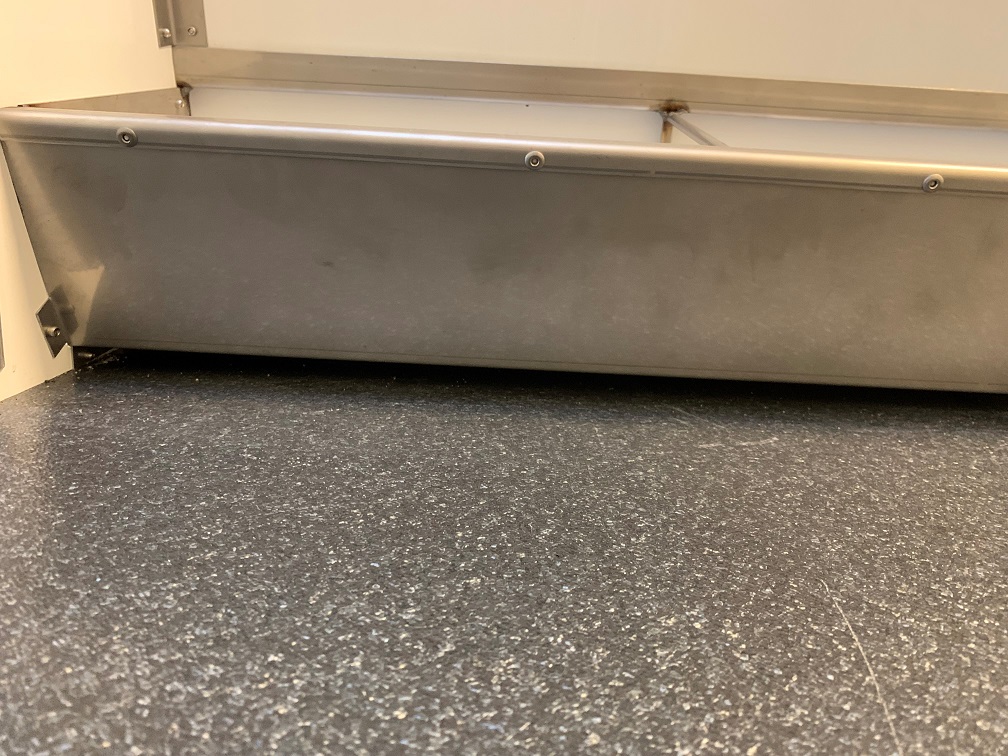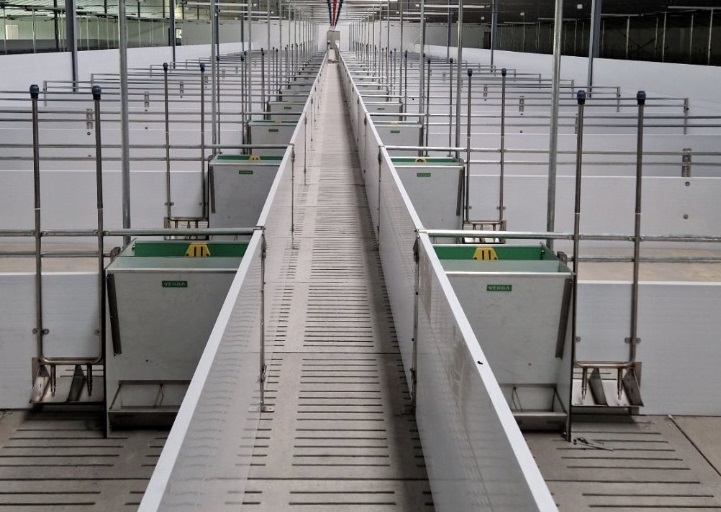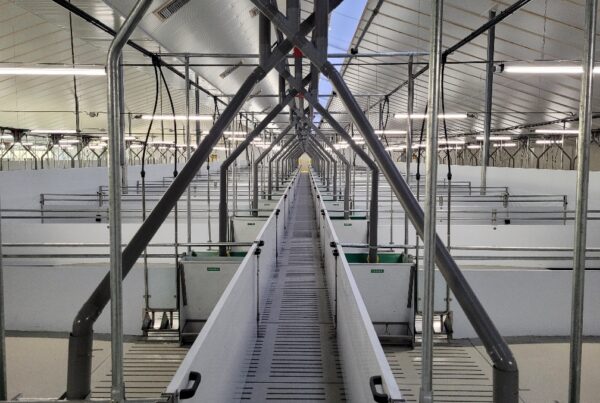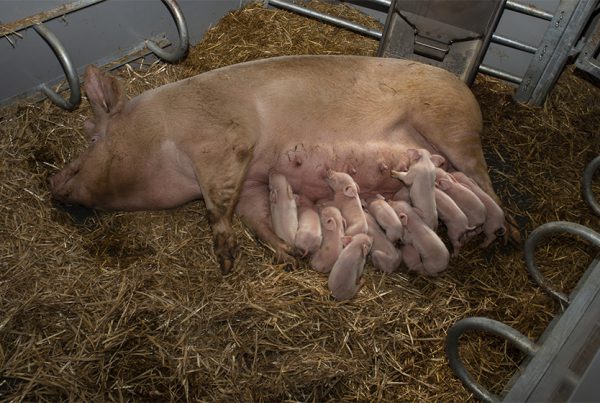Never change a winning team!
Never change a winning team! That's how we feel about our pig feeders. In over 50 years this has cost us blood, sweat and tears, but we have learned the hard way. Every time we received justified comments or warranty requests, we immediately adjusted our trough design accordingly. But in the end you have a top product, a "winning team," and then you have to maintain that quality. And that's why our VERBA pig dry feeders have been the same since 2010. Simply because over the years we have incorporated all solutions and comments into them and the price/quality ratio is optimal. Modifications increase the risk of comments; a more expensive pig feeder is excessive and a waste of money.
We give a 7-year warranty on our dry feeders for pigs, so we stay directly involved in the required quality for much longer. You won't see that with any other feed trough supplier!
In this article, we explain a few things about some deliberately chosen details.
Pop rivets or bolts with nuts?
In 97% of deliveries, we assemble our pig dry feeders with stainless steel pop rivets (blind rivets is the official term). The purchase price of stainless steel pop rivets is twice the purchase price of bolts and nuts. Also, the investment in pneumatic equipment in the workshop (tools, air lines and compressors) is higher for setting rivets than for electric hand tools for tightening bolts and nuts. On the other hand, assembly time is shorter with rivets.
But these are not the true reasons why we primarily mount dry feeders for pigs and piglets with stainless steel pop rivets. We always jokingly say: are airplanes and cars also mounted with nuts and bolts? The answer, of course, is no. And there are two good reasons for this: vibration and coefficient of expansion of materials.
Dry feeders for pigs are made of plastic sheet materials mounted together with stainless steel gussets. These sheet materials and stainless steel both have different expansion coefficients. With temperature fluctuations, stainless steel expands differently than the plastic sheet materials, which can cause the bolt and nut attachment to loosen. A good stainless steel blind rivet, on the other hand, pulls itself completely into the plastic sheet material. As a result, no space is created between these 2 materials during shrinkage. In addition, a lot of vibration takes place at pig feeders, 7 days a week and almost all day. Due to these movements of the pigs, bolts with lock nuts eventually vibrate loose and this is amplified when the plastic sheet materials and stainless steel have shrunk. If one does not keep checking and tightening the bolts and nuts consistently on a regular basis, the operation of the feeder and the adjustment is lost over time. This is the real reason why we use rivets to mount our dry pig feeders and single do so with nuts and bolts if our customers specifically request it. Because if the customer necessarily wants it, then of course we will do it (after explaining it properly first).
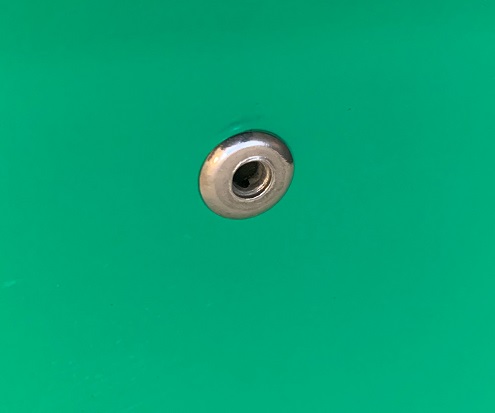
Slide adjustment or spindle adjustment?
Both are possible, but 95% of our customers want a slide adjustment. We can also make a stainless steel spindle adjuster. But why do we and most of our customers actually choose a slide adjustment?
Single 1 answer fits here: speed of adjustment. Speed and ease of labor are hugely important in our society because labor is scarce and expensive. You have to be economical with this.
The slide adjustment, like a spindle adjustment, is infinitely adjustable, but adjusting a pig dry feeder with a slide adjustment is done many times faster than with spindle adjustment. Imagine the following: you have a stable with 120 double-sided pig dry feeders with 2 spindles per side. You then have 240 bottom feeders to adjust by means of 2 spindles per side. One spindle lowers or raises a slide by 1.25mm per full 360 degree turn. The conclusion is that you have to turn an enormous amount to adjust all pig feeders correctly. In a slide adjustment, you unscrew the star knob and you can use the handle to raise and lower the slide as high and low as you want in 1 motion. If there is food under the slide that you really can't get through, just open the star knob, the slide will automatically lower as the pigs feed. Shortly thereafter, pull the slide with the slide adjustment to the desired height and secure it with the star knob. With a spindle you are so strong that if there is feed under the bottom slider that you can't get through with the bottom slider, you will destroy the whole spindle mechanism or the slider if you stoically keep turning. You should want to avoid this but unfortunately this sometimes happens with spindle adjustments due to time constraints. Would you still prefer a stainless steel spindle adjustment on your pig feeder: no problem, we make it!
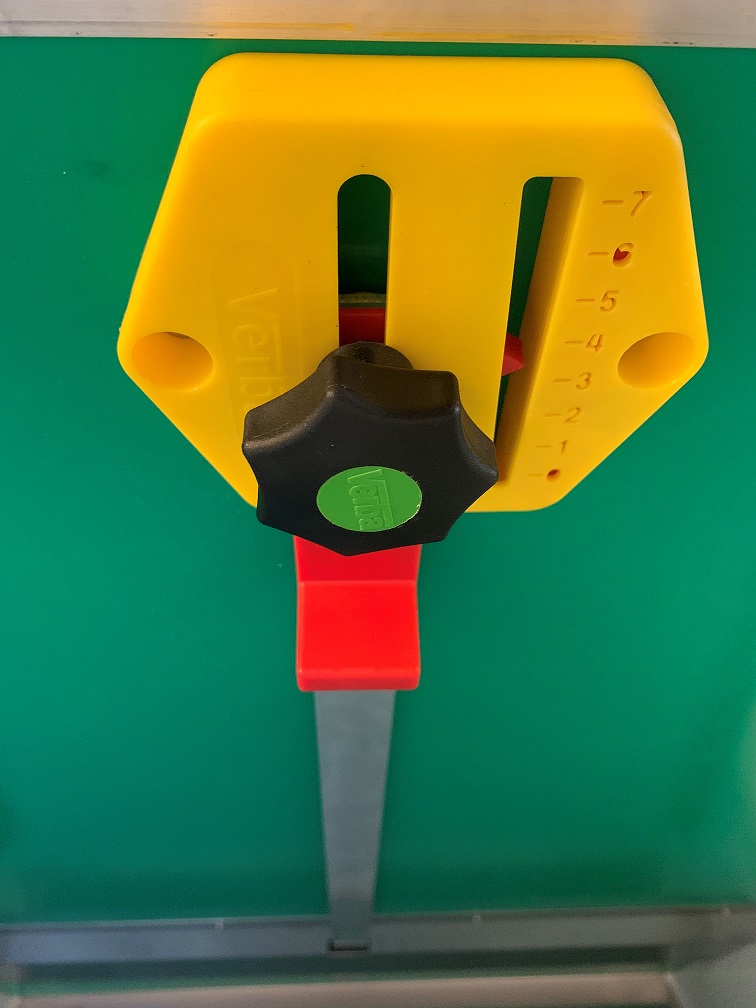
Plastic slide or stainless steel slide?
We supply both, but a stainless steel slide has a premium over the plastic slide because of the higher material cost. In over 85% of our sales we supply dry feeders for pigs with a plastic slide. We prefer plastic bottom feeders for two reasons. First of all, no heat passes through a plastic slide and this prevents bridging of the feed. If pigs are simultaneously eating at a trough, a lot of heat from the noses ends up on the slide. When the environment is colder or more humid, this body heat penetrates through the material of the slide with a 1.5 mm thick stainless steel slide and causes a lot of condensation on the inside/feeder side of the draft door. This can cause bridging of the feed, causing the feed to jam in the pig feeder. With an 11mm plastic slide you are guaranteed not to have this problem, not single because of the thickness of the material but also because plastic is a much better insulator than stainless steel. The second reason is price. Plastic is cheaper than stainless steel.
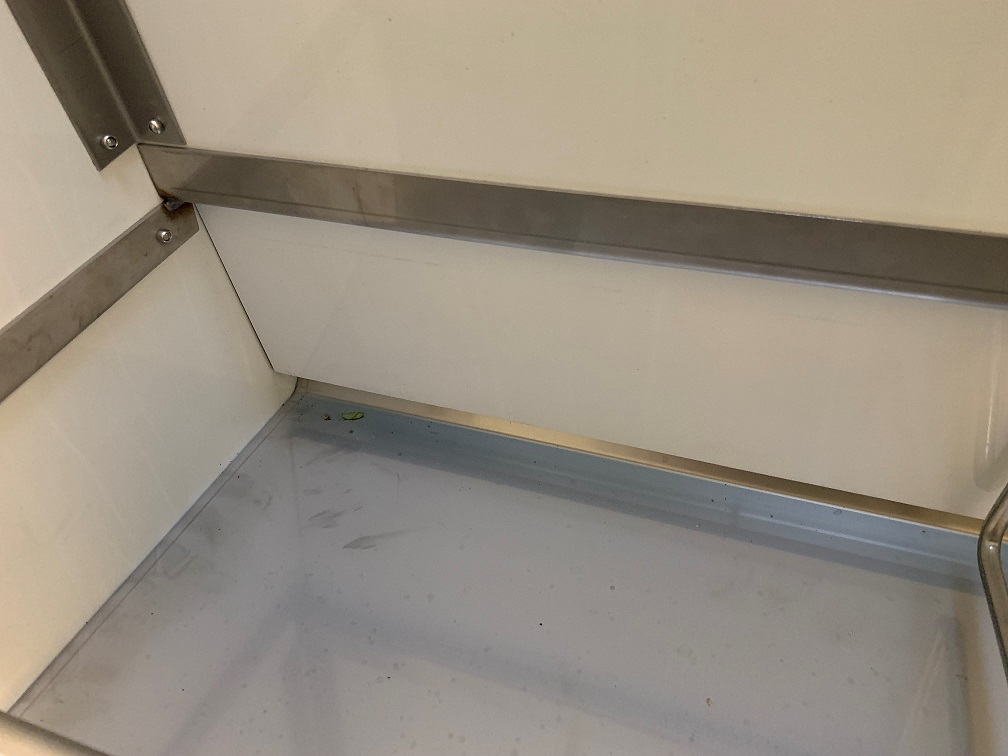
Spill edge
Over the years we have developed our own anti spillage rim for dry feeders. In dry feeders for pigs, these are really necessary because the pigs like to drink while eating. Because there is no drinking nipple in a dry feeder, the pigs walk away while eating. The special anti spillage rim that we have developed stops the food spilling to a large extent. Should you start comparing dry feeders, first see if they have a spill rim at all. If they do have one then see if that the inside of the spill rim also connects 100% to the trough plate. This ensures that no food can creep inside the spill edge which will rot here and destroy hygiene. Moreover, no ear tags can get stuck behind it, which is the case with an open anti-spill edge.
As an alternative to this anti spill edge, we very occasionally get asked if we can weld a round bar on the inside of the front of the trough across the entire width instead. We have done this a number of times by special request. We are convinced that the standard anti-spill edge works better, but welding in a round bar is possible.
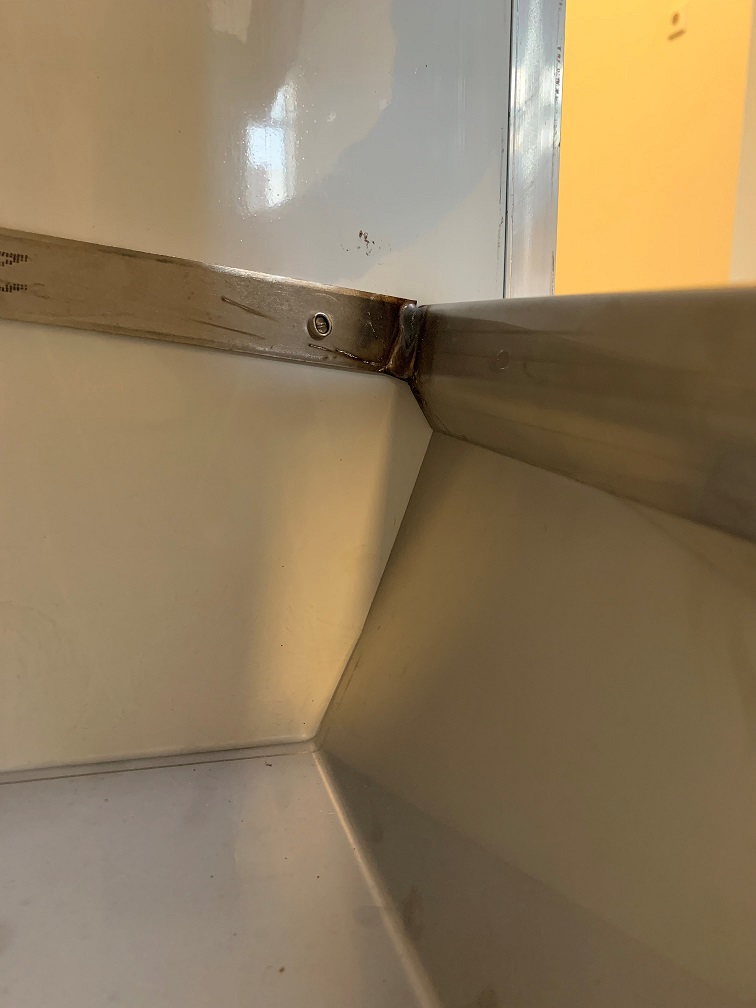
Open compartments or closed compartments?
Our pig dry feeders are equipped with open compartments between the eating compartments. On the SL feeders for piglets with Ø 6mm stainless steel round bar and on the SM feeders for fattening pigs with Ø 8mm stainless steel round bar. The compartments are provided with a bottom bracket so that pigs cannot get stuck. Because of these open dividers, pigs can see each other eating very well and seeing food makes them eat. In addition, a pig does not like to go head-to-head in a closed space; after all, a pig is a flight animal. Moreover, open compartments have the advantage that they are much easier to clean with the pressure washer. However, we can also weld the compartment dividers shut with a stainless steel plate if one wishes, but this has no advantages in our opinion.
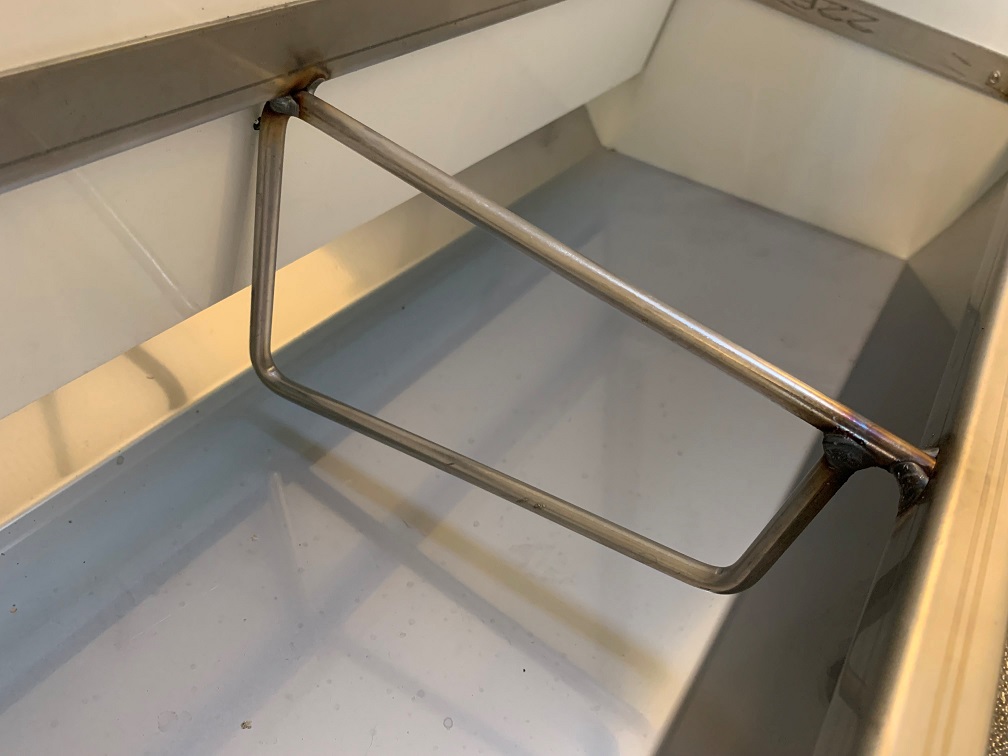
Feed trough on trough-front bottom open or closed?
We leave the feeder open at the front and never close it. This is for 3 reasons. First reason: if the space between the bottom of the trough of the pig feeder and the floor is open then you can also see what is underneath. If the front of the trough is closed and runs to the floor you can't see anything and it's just guessing what's underneath. Secondly, with an open bottom you can spray under it with the pressure washer should there actually be dirt or manure. So with the closed version, you can't spray under it which significantly increases the chance of pests. Third and final point: pitting corrosion. Stainless steel needs oxygen as a protective medium when damage occurs on the stainless steel. This ensures that stainless steel is and remains truly rustproof. Oxygen protects the antioxidant layer of stainless steel and keeps it from rusting through. If there is no oxygen, stainless steel can also simply rust through. Low to the floor in a pig stable the oxygen content is lower or zero (especially if the manure is too high in pit) and in addition the environment in a pig stable at pit height is aggressive. Therefore, if the front sides of the pig feeder are closed underneath and the stainless steel trough can single be aired through the bottom then no oxygen can reach it and the stainless steel trough can rust through quickly, despite being stainless steel.
In addition, with a piglet feeder, it is not good anyway to have a straight front of the trough. For a piglet that is still small and stands with its legs forward, it is good that it can stand partially with its legs under the trough that slopes inward. This allows him to reach the feed in the trough in a natural position. If the front is straight, the piglet has to stand further and in an unnatural position away from the trough. This makes access to the feed worse, which in turn is detrimental to growth.
